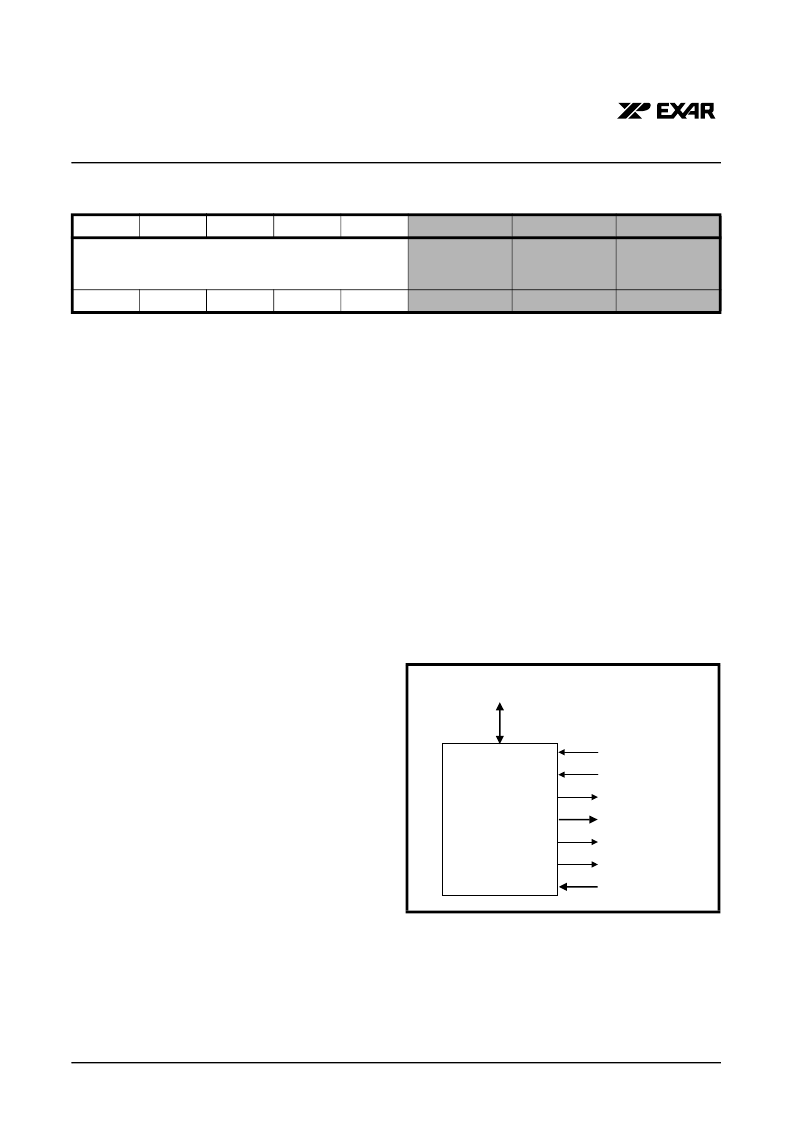- 您現(xiàn)在的位置:買賣IC網(wǎng) > PDF目錄376462 > XRT74L73IB (EXAR CORP) 3 CHANNEL, ATM UNI/PPP DS3/E3 FRAMING CONTROLLER PDF資料下載
參數(shù)資料
| 型號: | XRT74L73IB |
| 廠商: | EXAR CORP |
| 元件分類: | 數(shù)字傳輸電路 |
| 英文描述: | 3 CHANNEL, ATM UNI/PPP DS3/E3 FRAMING CONTROLLER |
| 中文描述: | DATACOM, FRAMER, PBGA388 |
| 封裝: | 35 X 35 MM, PLASTIC, BGA-388 |
| 文件頁數(shù): | 156/488頁 |
| 文件大?。?/td> | 2829K |
| 代理商: | XRT74L73IB |
第1頁第2頁第3頁第4頁第5頁第6頁第7頁第8頁第9頁第10頁第11頁第12頁第13頁第14頁第15頁第16頁第17頁第18頁第19頁第20頁第21頁第22頁第23頁第24頁第25頁第26頁第27頁第28頁第29頁第30頁第31頁第32頁第33頁第34頁第35頁第36頁第37頁第38頁第39頁第40頁第41頁第42頁第43頁第44頁第45頁第46頁第47頁第48頁第49頁第50頁第51頁第52頁第53頁第54頁第55頁第56頁第57頁第58頁第59頁第60頁第61頁第62頁第63頁第64頁第65頁第66頁第67頁第68頁第69頁第70頁第71頁第72頁第73頁第74頁第75頁第76頁第77頁第78頁第79頁第80頁第81頁第82頁第83頁第84頁第85頁第86頁第87頁第88頁第89頁第90頁第91頁第92頁第93頁第94頁第95頁第96頁第97頁第98頁第99頁第100頁第101頁第102頁第103頁第104頁第105頁第106頁第107頁第108頁第109頁第110頁第111頁第112頁第113頁第114頁第115頁第116頁第117頁第118頁第119頁第120頁第121頁第122頁第123頁第124頁第125頁第126頁第127頁第128頁第129頁第130頁第131頁第132頁第133頁第134頁第135頁第136頁第137頁第138頁第139頁第140頁第141頁第142頁第143頁第144頁第145頁第146頁第147頁第148頁第149頁第150頁第151頁第152頁第153頁第154頁第155頁當(dāng)前第156頁第157頁第158頁第159頁第160頁第161頁第162頁第163頁第164頁第165頁第166頁第167頁第168頁第169頁第170頁第171頁第172頁第173頁第174頁第175頁第176頁第177頁第178頁第179頁第180頁第181頁第182頁第183頁第184頁第185頁第186頁第187頁第188頁第189頁第190頁第191頁第192頁第193頁第194頁第195頁第196頁第197頁第198頁第199頁第200頁第201頁第202頁第203頁第204頁第205頁第206頁第207頁第208頁第209頁第210頁第211頁第212頁第213頁第214頁第215頁第216頁第217頁第218頁第219頁第220頁第221頁第222頁第223頁第224頁第225頁第226頁第227頁第228頁第229頁第230頁第231頁第232頁第233頁第234頁第235頁第236頁第237頁第238頁第239頁第240頁第241頁第242頁第243頁第244頁第245頁第246頁第247頁第248頁第249頁第250頁第251頁第252頁第253頁第254頁第255頁第256頁第257頁第258頁第259頁第260頁第261頁第262頁第263頁第264頁第265頁第266頁第267頁第268頁第269頁第270頁第271頁第272頁第273頁第274頁第275頁第276頁第277頁第278頁第279頁第280頁第281頁第282頁第283頁第284頁第285頁第286頁第287頁第288頁第289頁第290頁第291頁第292頁第293頁第294頁第295頁第296頁第297頁第298頁第299頁第300頁第301頁第302頁第303頁第304頁第305頁第306頁第307頁第308頁第309頁第310頁第311頁第312頁第313頁第314頁第315頁第316頁第317頁第318頁第319頁第320頁第321頁第322頁第323頁第324頁第325頁第326頁第327頁第328頁第329頁第330頁第331頁第332頁第333頁第334頁第335頁第336頁第337頁第338頁第339頁第340頁第341頁第342頁第343頁第344頁第345頁第346頁第347頁第348頁第349頁第350頁第351頁第352頁第353頁第354頁第355頁第356頁第357頁第358頁第359頁第360頁第361頁第362頁第363頁第364頁第365頁第366頁第367頁第368頁第369頁第370頁第371頁第372頁第373頁第374頁第375頁第376頁第377頁第378頁第379頁第380頁第381頁第382頁第383頁第384頁第385頁第386頁第387頁第388頁第389頁第390頁第391頁第392頁第393頁第394頁第395頁第396頁第397頁第398頁第399頁第400頁第401頁第402頁第403頁第404頁第405頁第406頁第407頁第408頁第409頁第410頁第411頁第412頁第413頁第414頁第415頁第416頁第417頁第418頁第419頁第420頁第421頁第422頁第423頁第424頁第425頁第426頁第427頁第428頁第429頁第430頁第431頁第432頁第433頁第434頁第435頁第436頁第437頁第438頁第439頁第440頁第441頁第442頁第443頁第444頁第445頁第446頁第447頁第448頁第449頁第450頁第451頁第452頁第453頁第454頁第455頁第456頁第457頁第458頁第459頁第460頁第461頁第462頁第463頁第464頁第465頁第466頁第467頁第468頁第469頁第470頁第471頁第472頁第473頁第474頁第475頁第476頁第477頁第478頁第479頁第480頁第481頁第482頁第483頁第484頁第485頁第486頁第487頁第488頁

XRT74L73
3 CHANNEL, ATM UNI/PPP DS3/E3 FRAMING CONTROLLER
REV. P1.0.1
PRELIMINARY
157
The bit format of the RxCP Interrupt Status Register
indicates that only three (3) bit-fields within this register
are active. The role of each of these bit fields follows.
Bit 0—HEC Byte Error Interrupt Status
A “1” in this “Reset-upon-Read” bit-field indicates the
Receive Cell Processor has detected a HEC Byte
error in an incoming cell, and has requested a “HEC
Byte Error” Interrupt, since the last read of this register.
Bit 1—“Change in LCD (Loss of Cell Delineation)
State” Interrupt Status
A “1” in this “Reset-upon-Read” bit-field indicates that
the Receive Cell Processor has changed its “LCD”
(Loss of Cell Delineation) state and has issued the
“Change in LCD State” interrupt, since the last read
of this register.
Note: This type of interrupt could occur due to a transition
from the SYNC state to the HUNT state, in the “HEC Byte
Cell Delineation Algorithm”; during which the RxLCD pin will
toggle “high”. Additionally, this type of interrupt could also
occur due to the transition from the PRE-SYNC state into
the SYNC state. The user can distinguish between these two
possibilities by reading the RxLCD bit-field (bit 7) in the RxCP
Configuration Register (Address = 4Ch).
Bit 2—Received OAM Cell Interrupt Status
A “1” in this “Reset-upon-Read” bit-field indicates that
the Receive Cell Processor has detected an OAM
Cell in the path of “incoming cells”; and has stored the
contents of this OAM cell in the “Receive OAM Cell
Buffer”, since the last read of this register. The pur-
pose of this interrupt is to alert the local μP/μC that
the “Receive OAM Cell Buffer” (within the UNI) con-
tains an OAM cell that needs to be read and
processed.
3.4Receive UTOPIA Interface Block
3.4.1Brief Description of the Receive UTOPIA
Interface Block
The Receive UTOPIA Interface Block provides a
“UTOPIA Level 2” compliant interface to interconnect
the UNI chip to ATM layer or ATM Adaptation Layer
processors, operating up to 800 Mbps. This interface
supports both an 8 and 16 bit wide data bus. Since
data is received at clock rates independent of the
ATM layer clock rate, the received cell data is written
into an internal FIFO by the Receive Cell Processor
block. This FIFO will be referred to as the RxFIFO
throughout this document. The Receive Cell Processor
will delineate, check for HEC byte errors, filter and
de-scramble ATM Cells. Whatever cells were not
discarded by the Receive Cell Processor will be
written into the RxFIFO, where it can be read out from
the UNI device by the ATM Layer Processor. The Re-
ceive UTOPIA Interface Block will inform the ATM
Layer processor that it has cell data available for
reading, by asserting the RxUClav pin “high”.
Figure 35 on the following page presents a simple il-
lustration of the Receive UTOPIA Interface block and
the associated pins.
3.4.2Functional Description of Receive UTOPIA
The purposes of the Receive UTOPIA Interface block
are to:
Receive filtered ATM cell data from the Receive
Cell Processor and make this data available to the
AAL or ATM Layer Processor.
RxCP Interrupt Status Register (Address = 4Ch)
B
IT
7
B
IT
6
B
IT
5
B
IT
4
B
IT
3
B
IT
2
B
IT
1
B
IT
0
Unused
Received OAM
Cell Interrupt Sta-
tus
LCD
Interrupt Status
HEC Error
Interrupt Status
RO
RO
RO
RO
RO
RUR
RUR
RUR
F
IGURE
35. S
IMPLE
B
LOCK
D
IAGRAM
OF
R
ECEIVE
UTO-
PIA B
LOCK
OF
UNI.
Receive Utopia
Interface
RxClk
RxEnB
RxPrty
RxData[15:0]
RxSoC
RxClav/RxEmptyB*
RxAddr[4:0]
From Receive Cell Processor
相關(guān)PDF資料 |
PDF描述 |
|---|---|
| XRT74L74 | 4 CHANNEL, ATM UNI/PPP DS3/E3 FRAMING CONTROLLER |
| XRT74L74IB | 4 CHANNEL, ATM UNI/PPP DS3/E3 FRAMING CONTROLLER |
| XRT75L00D | E3/DS3/STS-1 LINE INTERFACE UNIT WITH SONET DESYNCHRONIZER |
| XRT75L00DIV | E3/DS3/STS-1 LINE INTERFACE UNIT WITH SONET DESYNCHRONIZER |
| XRT75L02 | TWO CHANNEL E3/DS3/STS-1 LINE INTERFACE UNIT WITH JITTER |
相關(guān)代理商/技術(shù)參數(shù) |
參數(shù)描述 |
|---|---|
| XRT74L74 | 制造商:EXAR 制造商全稱:EXAR 功能描述:4 CHANNEL, ATM UNI/PPP DS3/E3 FRAMING CONTROLLER |
| XRT74L74IB | 制造商:EXAR 制造商全稱:EXAR 功能描述:4 CHANNEL, ATM UNI/PPP DS3/E3 FRAMING CONTROLLER |
| XRT75L00 | 制造商:EXAR 制造商全稱:EXAR 功能描述:E3/DS3/STS-1 LINE INTERFACE UNIT WITH JITTER ATTENUATOR |
| XRT75L00D | 制造商:EXAR 制造商全稱:EXAR 功能描述:E3/DS3/STS-1 LINE INTERFACE UNIT WITH SONET DESYNCHRONIZER |
| XRT75L00DES | 功能描述:時鐘合成器/抖動清除器 LIU+DESYNCH 3.3V LIU+DESYNCH 3.3V RoHS:否 制造商:Skyworks Solutions, Inc. 輸出端數(shù)量: 輸出電平: 最大輸出頻率: 輸入電平: 最大輸入頻率:6.1 GHz 電源電壓-最大:3.3 V 電源電壓-最小:2.7 V 封裝 / 箱體:TSSOP-28 封裝:Reel |
發(fā)布緊急采購,3分鐘左右您將得到回復(fù)。